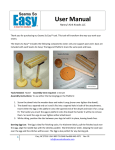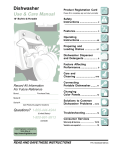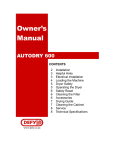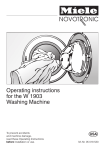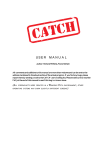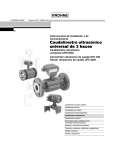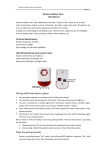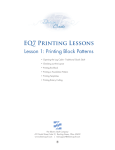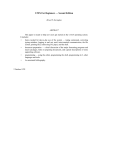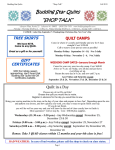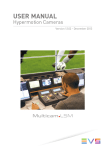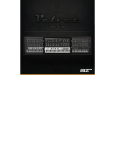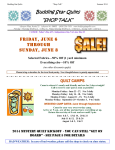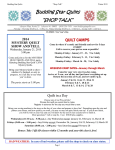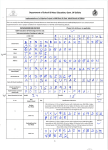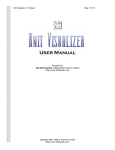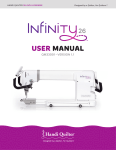Download Materials & Prep List - RaNae Merrill Quilt Design
Transcript
AMC Fire Island Needlework Workshop with RaNae Merrill These workshops afford you the opportunity to learn the basics of quilting, knitting and crochet. I will also share the basics of my “spiral” and “spiral mandala” techniques. Feel free to participate in as much or as little of the workshops as you wish. There will be lots of time in the afternoons to enjoy the beach and explore Fire Island. In the evenings enjoy open studio time to work on class projects or bring a project of your own. The quilting classes are based on my books Simply Amazing Spiral Quilts and Magnificent Spiral Mandala Quilts. Copies of books will be available for purchase at the workshop. Proposed topics and schedule: (Subject to change, depending on interest, skill levels of participants, and weather.) Day 1: Morning Workshop, 9:00-12:00: Quilting Basics: rotary cutting, 1/4” seam allowances, Log Cabin block, Spiral block, hand stitching & foundation piecing (depending on skill level and interest) Knitting: Basic stitches (cast on, knit, purl) (new knitters teamed with experienced knitters) Crochet: Basic stitches (chain, single, double) (new crocheters teamed with experienced crocheters) Afternoon: Free time to explore the island, relax on the beach, etc. Needlework if you want to. After dinner: Open studio -- Follow-up to the morning’s workshops. I’ll be there to guide, answer questions, and do a bit of sewing myself Day 2: Morning Workshop, 9:00-12:00: Quilting: Layering and quilting, combining spirals Knitting: Combining knit & purl (new knitters teamed with experienced knitters) Crochet: Combined-stitch pattern (new crocheters teamed with experienced crocheters) Afternoon: Free time to explore the island, relax on the beach, etc. Needlework if you want to. After dinner: Open studio -- Follow-up to the morning’s workshops. I’ll be there to guide, answer questions, and do a bit of sewing myself Day 3: Morning Workshop, 9:00-12:00: Quilting: Introduction to spiral mandala design Knitting: Binding off (new knitters teamed with experienced knitters) Crochet: Combined-stitch patterns (new crocheters teamed with experienced crocheters) Afternoon: Free time to explore the island, kayak, etc. Needlework if you want to. Pack and leave anytime throughout the day, depending on the ferry schedule. Copyright © 2012 RaNae Merrill All rights reserved www.ranaemerrillquilts.com For Quilting: PROJECT: We’ll learn to piece the traditional Log Cabin block and a spiral variation In class you will sew one or more single blocks that can be finished into a simple pot holder; if you want to make more blocks you can combine them for a table runner or quilt. On Day 3, you have the opportunity to create a design for a multipleblock “spiral mandala quilt” (see example at right). Traditional Log Cabin block Spiral block “Spiral Mandala” quilt Tools: (Items marked with asterisks will be available for purchase in class) For drawing blocks: In addition, if you want to design a mandala: _____ Scissors for paper _____ 2 clear plastic page protectors _____ Pencil _____ Dry-erase markers or crayons in a variety of _____ Fine-point permanent black pen colors. (See notes below.) _____ 12” Ruler _____ 15-20 Q-tips _____ Several sheets of white paper 8-1/2” x 11” _____ *A pair of mirrors at least 8” x 10”, taped _____ Scotch tape together along one edge to make a hinge (if they are rectangular tape them along the shorter edge). Mirrors available in class are non-breakable. If you bring glass mirrors, cover the entire back of the mirrors with tape, so that they will not shatter if dropped. (See next page about pre-ordering mirrors.) For sewing: _____ Basic sewing tools: pins, scissors, needle, etc. _____ Thread that matches your fabrics, or neutral colored thread, for sewing _____ Hand-quilting thread that matches your fabrics _____ Rotary cutter with ruler & mat (if you have it) _____ Two highlighter pens in different colors _____ Double-sided tape (permanent, not the removable kind) _____ Masking or painter’s tape _____ *Add-a-Quarter tool _____ *Seam roller (optional, but really helpful) _____ Sewing machine (optional) Fabric: Bring an assortment of light and dark fabrics, some solids and some patterns. You will not need more than 1 yard total for the blocks we will sew in the workshop. Copyright © 2012 RaNae Merrill All rights reserved www.ranaemerrillquilts.com Markers: If you plan to participate in the spiral mandala design workshop, bring dry-erase markers or dry-erase crayons in variety of colors, preferably colors that correspond to your fabric colors. (Typical water-based markers don’t work on the plastic page protectors that you’ll be using to color your quilt designs.) Markers can be ordered from www.Staples.com: Items #643515, #829386, #567488, #554359. Dry erase crayons are Item # 833842. Type any of these numbers into the “Search” field to find them. Sewing Machine Set-up: If you bring a machine, set it up with a 75/11 or 80/12 needle. Use a foot that allows you to clearly see lines on the foundation, such as an open-toe foot, or a clear foot with a center-line mark. Be sure to bring bobbins and extra needles. You might also need an extension cord or power strip. Items available for purchase in class: Class kit: I will have printed course materials available for a nominal charge. Cost will vary depending on the amount of material in the kit. It is strongly recommended that you print out and bring with you the online materials indicated in the course descriptions for knitting and crochet. Quilting kits will contain class instructions, pre-printed templates and foundations used in class. Instructions for completing a spiral mandala quilt will also be available. Mirrors, $25: Each person participating in the spiral mandala class on the third day needs their own set of hinged mirrors. Mirrors available for purchase in class are non-breakable and lightweight so they are safe for travel. It is recommended that you pre-order your set by sending an email to [email protected]. In the “Subject” line write MIRRORS, YOUR NAME and your GUILD, STORE OR EVENT NAME. Fabric: I will have a limited amount of fabrics with me available for purchase. Books, $30 each, both for $50: Both of my books Simply Amazing Spiral Quilts and Magnificent Spiral Mandala Quilts contain the essentials of drawing and sewing spiral blocks. If you want to design a spiral mandala quilt, it is strongly recommended that you purchase a copy of Magnificent Spiral Mandala Quilts. The books are helpful, but not required in class. Tools: In the tools list on the first page, items marked with an asterisk will be available for purchase in class. To order Simply Amazing Spiral Quilts, Magnificent Spiral Mandala Quilts and other supplies, go to www.ranaemerrillquilts.com -- click on “STORE” Join RaNae on Facebook -- become a friend! Visit the Spiromaniacs blog (more on SASQ) at http://spiromaniacs.wordpress.com Visit the Spiromandalas blog (more on MSMQ) at http://spiromandalas.wordpress.com Sign up to receive the Spiromaniacs newsletter and a free pattern at www.ranaemerrillquilts.com/join For more information about Spiral Quilt workshops and lectures, go to www.ranaemerrillquilts.com/teaching, or contact RaNae at [email protected] or 212-316-2063 Corrections, suggestions, questions? [email protected]/contact All designs, patterns & instructions Copyright © 2010 RaNae Merrill All rights reserved. These materials are solely for use by RaNae Merrill in her workshops, and may not be used by any other person or organization for any purpose (whether or not for profit) unless specifically authorized to do so in writing by RaNae Merrill. 1/28/13 Copyright © 2012 RaNae Merrill All rights reserved www.ranaemerrillquilts.com For Knitting: If you have not knitted before (or it has been a long time since you knitted) here is an excellent set of illustrated instructions: http://www.lionbrand.com/learntoKnit.pdf Please print them out at least through Step 7 and bring them with you. (The site also provides these instructions in video form.) PROJECT: Scarf -- the pattern below uses simple alternating knit and purl stitches to create an elegant woven pattern. Once you know how to do the stitches, feel free to experiment and vary the pattern any way you wish. April Scarf http://fetchingknits.thruhere.net/content/view/64/32/ From the designer: In my head, all the months of the year have colours. January is black, May is asparagus green, November is chocolate brown, August is tropical orange, and April is turquoise. This is a simple scarf made from handpainted bamboo that I designed for my mum for Mothers’ Day. It’s been a really cold spring and she needs a little something to keep her warm when she’s out walking, but it’s too depressing to wear winter scarves this close to “summer”. Mum loves turquoise, and I thought of her immediately when I saw this yarn. It’s meant for weaving, and not ironically, the scarf is worked in a simple knit/purl pattern that looks like those woven paper projects you make in elementary school. Materials 1 skein (4 oz, 525 yards) Northern Brights 100% regenerated bamboo. (*Note: project is worked with 2 strands of yarn held together throughout. This is really the only tricky part because the yarn is a bit slippery and can tangle easily.) Or, any comparable medium-weight yarn that you like. 3.75 mm straight needles (U.S Size 5) (The designer recommends bamboo or wood if you are using the bamboo yarn--the yarn might be too slippery for metal or plastic. If you are purchasing needles and yarn, ask the person at the yarn shop what type of needles they recommend for use with your yarn.). Copyright © 2012 RaNae Merrill All rights reserved www.ranaemerrillquilts.com Pattern notes: Pattern 3 (wide “weave”) Pattern 1 (narrow “weave”) Row 1: K6 P6 K6 P6 K6 Row 2: P6 K6 P6 K6 P6 Row 3: same as row 1 Row 4: same as row 2 Row 5: same as row 1 Row 6: same as row 2 Row 7: same as row 1 Repeat rows 1 to 7 for pattern Row 1: K6 P6 K6 P6 K6 Row 2: P6 K6 P6 K6 P6 Row 3: same as row 1 Repeat rows 1 to 3 for pattern Pattern 2 (medium width “weave”) Row 1: K6 P6 K6 P6 K6 Row 2: P6 K6 P6 K6 P6 Row 3: same as row 1 Row 4: same as row 2 Row 5: same as row 1 Repeat rows 1 to 5 for pattern Pattern 4 (full-width “stripes”) Row 1: K Row 2: P Row 3: K Repeat rows 1 to 3 for pattern Instructions With two strands of yarn held together, cast on (CO) 30 stitches (sts). [R: If you want to make the scarf wider, cast on additional stitches in multiples of 6.] Narrow weave Work 26 repeats of Pattern 1 Work 20 repeats of Pattern 2 Work 10 repeats of Pattern 3 Work 20 repeats of Pattern 2 Work 15 repeats of Pattern 1 Work 7 repeats of Pattern 4 Full-width stripe Bind off (BO) all stitches to finish. Copyright © 2012 RaNae Merrill All rights reserved www.ranaemerrillquilts.com For Crochet: If you have not crocheted before (or it has been a long time since you knitted) here is an excellent set of illustrated instructions: http://learntocrochet.lionbrand.com. (The site also provides these insturctions in video form.) Please print out the illustrated instructions at least through Step 10. PROJECT: A crocheted block that can be used as a dishcloth, or make more for an afghan. (It also happens to be similar to a traditional Log Cabin quilt block.) MATERIALS: Download and print this pattern: http://cache.lionbrand.com/printablePatterns/L10740.pdf or http://www.lionbrand.com/patterns/L10740.html?noImages= Crochet hook size Size H-8 (5 mm) Small amounts of 4 colors of kitchen cotton yarn (see pattern) (It must be cotton for dishcloths. If you are going to use the blocks for something else it can be another type of fiber with a similar weight and gauge. This is a good “scrappy” project.) If you want a larger project, here’s an afghan project from the same company that is simple and made from blocks very similar to the one above: http://www.lionbrand.com/patterns/L10627. html?noImages= Copyright © 2012 RaNae Merrill All rights reserved www.ranaemerrillquilts.com Making a Wedge Puzzle 2. Draw 3 or 4 straight lines across it in random directions to divide it into shapes. (Try this with your eyes closed. If necessary, straighten the lines with a ruler.) Using the mirrors, select one wedge. 1. Start with a pie. 3. Enlarge the wedge to 10”. This is the “wedge skeleton.” Make 2 copies of the skeleton page. Draw over the skeleton lines with a highlighter pen. On the original, number each shape at the center, then put the original inside the page protector. WEDGE PUZZLE FOR MAGIC MIRROR MANDALA SKELETON (10” wedge) 1/8-wedge: Asymmetrical with Matching Side Nodes (AMSN) (C) 2010 RaNae Merrill May be copied for personal use 1 3 2 4 4. On one copy of the skeleton, draw a clockwise (C) Nesting spiral in each shape. Use the same length increment (3/4” - 1” is a good distance) in the first ring of each spiral. Number these spirals the same as the numbers in the skeleton, and put a “C” after each number. 5 5. On the other copy of the skeleton, draw a counterclockwise (X) Nesting spiral in each shape. Use the same length increment (3/4” - 1” is a good distance) in the first ring of each spiral. Number these spirals the same as the numbers in the skeleton, and put an “X” after each number. WEDGE PUZZLE FOR MAGIC MIRROR MANDALA WEDGE PUZZLE FOR MAGIC MIRROR MANDALA CLOCKWISE SPIRALS (C) (10” wedge) COUNTER-CLOCKWISE SPIRALS (X) (10” wedge) 1/8-wedge: Asymmetrical with Matching Side Nodes (AMSN) (C) 2010 RaNae Merrill May be copied for personal use 1C 3C 2C 4C Steps 1-5 have been done for you. The wedge skeleton and spirals for your wedge puzzle can be found on the next three pages. 1/8-wedge: Asymmetrical with Matching Side Nodes (AMSN) (C) 2010 RaNae Merrill May be copied for personal use 1X 3X 2X 4X 5C 5X 6. Cut apart the two spiral pages along the highlighted lines. Put a roll of scotch tape on the back of each one. 7. Mix and match the clockwise and counterclockwise spirals by sticking them on the skeleton in the page protector. Look at them in the mirrors to see your Magic Mirror Mandala! 8. When you find an arrangement you like, slide the entire block puzzle into another page protector. Replace the mirrors. Use dry-erase markers to color your design. WEDGE PUZZLE FOR MAGIC MIRROR MANDALA SKELETON (10” wedge) 1/8-wedge: Asymmetrical with Matching Side Nodes (AMSN) (C) 2010 RaNae Merrill May be copied for personal use 1 3 2 4 5 WEDGE PUZZLE FOR MAGIC MIRROR MANDALA CLOCKWISE SPIRALS (C) (10” wedge) 1/8-wedge: Asymmetrical with Matching Side Nodes (AMSN) (C) 2010 RaNae Merrill May be copied for personal use 1C 3C 2C 4C 5C WEDGE PUZZLE FOR MAGIC MIRROR MANDALA COUNTER-CLOCKWISE SPIRALS (X) (10” wedge) 1/8-wedge: Asymmetrical with Matching Side Nodes (AMSN) (C) 2010 RaNae Merrill May be copied for personal use 1X 3X 2X 4X 5X Flow Forms When two spirals sit side-by-side, the spokes connect to create a new shape between them. This is a flow form. A flow form can be a fan or a trunk. Two spirals spinning in opposite directions (C + X) create a Fan (Hint: fans always appear along the mirror, and can also appear in the middle of the wedge) X Two spirals spinning in the same direction (C + C or X + X) create a Trunk (Hint, trunks never appear along the mirrors, only in the center of the wedge) C C C If you change the proportions of the outside shape, the flow form also changes proportions. Trunk Fan The more you change the proportions of the shape, the more the proportions of the spokes and flow forms change. If a side of the shape is short, the spoke on that side of the spiral is thin, like a ribbon (yellow spoke). If the side of the shape is long, the spoke on that side of the spiral is wide, like a petal (red spoke). These proportions carry into the flow forms when the spirals connect. Copyright © 2012 RaNae Merrill All rights reserved www.ranaemerrillquilts.com Coloring your Mandala: 6 Ways to Color a Flow Form Slit the second page protector down one of its long sides. Slide your assembled wedge puzzle into it. Replace the mirrors over the wedge puzzle. Using overhead projector markers or dry-erase markers, color your mandala. Use Q-tips as erasers if you want to change colors. Think about coloring the flow forms in these ways: Linked Solid Split Variegated Gradation Flowunder THE MOST IMPORTANT THING TO REMEMBER ABOUT COLORING YOUR MANDALA IS TO KEEP LIGHT NEXT TO DARK SO THAT THE STRUCTURE CAN BE SEEN CLEARLY. Copyright © 2012 RaNae Merrill All rights reserved www.ranaemerrillquilts.com Coloring your Mandala: Design, Value & Fabric Design As you color your design, think of it as if it were a story. Starting at the center of the design, work freely and place colors in any position that you wish. After you have colored for 10 minutes, or have filled in the center to about 1/3 of the way out toward the edge, stop and examine what you have so far. Look for 2 or 3 strong ideas in what you have colored. These could be a certain combination of colors side-by-side, a specific way of coloring a flow form, etc. Think of these motifs as characters in your story. Now, as you move outward in your design let these motifs, or “characters”, appear again in the middle and outer portions of the design, in similar shapes or positions in the design. Each time you use a motif, it will be recognizable and yet change a little -most often in the proportions of the flow form in which you place it. Think of it like your character developing and changing through the course of a story. Use a digital camera to record possible colorings until you arrive at a coloring you like. Value Remember, value, even more than color, defines a design. Your design needs strong contrast for the shapes to show up. Place contrasting values wherever you want to separate and define shapes -- for example in adjacent spokes or flow forms. Colors with similar values clump together visually. Colors with contrasting values separate visually. Place similar values wherever you want to hold a shape together -- for example within a spoke or flow form. (For more on value, read SASQ pgs 69-73 and MSMQ pg 40.) Fabrics I separate fabrics into three types: Foundation Fabrics, Energy Fabrics and Jewelry Fabrics. (For more on this, see MSMQ pgs 52-55.) Each type plays a different role in your spiral mandala design. Foundation Fabrics Foundation fabrics read as solid colors. They can be solids, single-color textures, tone-on-tones and small non-directional prints. These are ideal for spirals, because they fit in small areas and it doesn’t matter which direction they sit in the design. However, if you use all foundation fabrics you’ll likely to end up with a somewhat dull design. The solid colors of foundation fabrics help define the structure of a design. Energy Fabrics Energy fabric have a medium-size pattern that includes two or more colors. Energy fabrics add rhythm, texture and pizzazz to your design. The colors should be evenly distributed in the fabric, so that when you cut them each piece is the same color. (Avoid “blotchies” - the color changes over large areas of the design so that some of the pieces are different colors. If you do use a blotchy you may need to fussy-cut it to get the right color in all pieces.) Place energy fabrics in your design anywhere you want some excitement or movement Energy fabrics placed side-by-side will blend. If you want to contain and separate energy fabrics from other fabrics, place foundation fabrics around them. Jewelry Fabrics Jewelry fabrics are large-scale fabrics with interesting designs that you fussy-cut in your design. Their strong design and larger scale provide a focal point, just like a piece of jewelry you wear. Place a jewelry fabric in at least two positions in the design, so it balances. Here are some ideas: centers of spirals (Tropicale, SASQ pg 63), borders (Purple Spiral #1, SASQ pg 28), a single triangle in each spiral that creates a secondary, kaleidoscopic effect (Jade Crystals, SASQ pg 37 -- the purple is a solid, but the same thing could be done with a jewelry fabric, perhaps even fussy-cut), the background, then work the spiral design in solids over it (Crest of the Crane, MSMQ pg 55). Copyright © 2012 RaNae Merrill All rights reserved www.ranaemerrillquilts.com Turning Your Wedge Puzzle Into a Quilt Important Note: SAVE THIS PAGE! The information and templates provided here are only as much as you will need to complete the first 1-2 blocks of your quilt in class. The complete set of spiral templates, as well as step-by-step instructions for completing the whole quilt, are available on the Spiromandalas Blog at http://spiromandalas.wordpress.com/magic-mirror-mandala You must sign in to this page with the password rorriM3272. Preparing Foundations and Sewing - In Class Once you have decided on your layout and coloring, take out the white paper copy of Spiral 1 -- either the clockwise or counterclockwise spiral, whichever is in your wedge. Mark both copies with the colors on your colored wedge puzzle. (It is best to write the names of these colors, rather use colored pens, because you will make photocopies later on, and the written names will copy, but colored markers won’t..) Next, take out the foundation sheet of Spiral 1 and cut off the C or X templates, whichever correspond to your design. (Leave at least 1/4” extra material around the template). Lay the foundation over the wedge puzzle or master template and mark it with the colors of your design. Cover the back of one of the paper templates with double-sided tape. Lay out all the fabrics you will use in this spiral. Cut apart the sticky templates and stick them to their corresponding fabric. For each template, cut a rectangular strip 1/4” larger than the template on each side. DO NOT cut triangles. Do not cut extra-large. Leave the templates on the fabric and stack the cut strips alphabetically -- all the A’s, all the B’s all the C’s. Sew the spirals according to the instructions for sewing Nesting spirals. (This is demonstrated in class. Instructions can also be found in either of my books.) For Spiral #4 it is particularly important that you sew each ring in NUMERICAL ORDER. Use a sewing machine foot that allows you to clearly see the lines on the foundation. Set your stitch length to about 15 stitches per inch (setting 1.5 on most machines) for leave-in foundation; for paper foundation, set stitch length to approx. 20 stitches per inch (setting 1.2 on most machines). After completing each spiral block, trim excess fabric and foundation, leaving 1/4” seam allowance beyond the outside line. Using EQ to create a mandala You cannot switch around sections of a wedge puzzle in EQ, but you can print the spirals using Print Foundation Pattern (EQ6 User Manual pp 270-71). From the PDF materials provided here and on the web page, print the skeleton block, the all-clockwise spirals block and the all-counterclockwise spirals block to make your wedge puzzle. Rearrange and experiment with the wedge puzzle. When you have settled on a design, photograph or scan the block and import it into EQ so that you can trace it to create your actual wedge in EQ (EQ6 User’s Manual pp 262-264). Assuming you are creating an 8-wedge mandala, fill the block with a second copy of the wedge. Once your wedge block is drawn, place it in a 4-block quilt layout. Use the Flip Block and Rotate Block functions to mirror the block. You can now use EQ to easily experiment with color. Remember that if you hold down the Control key as you put color into a block, it will color the same area of all copies of that block in the same way. Add borders using the Borders tab. When you are ready to sew, print the spiral foundations on translucent foundation material using Print Foundation Templates. You can print the templates at any size you wish. There is more information about creating mandalas in EQ on the CD that comes with Magnificent Spiral Mandala Quilts. Copyright © 2012 RaNae Merrill All rights reserved www.ranaemerrillquilts.com FOUNDATIONS FOR SPIRAL 1 (10” wedge) (1C ) E4 B4 (1X) (1X) C4 (1X) C3 (1X) D3 (1X) E out side 3 Trim line side do ut /4 ” b eyo n (1C) A4 a line foseam for r seam a l l o wan (1C) D1 ce (1C) C1 (1C ) B1 C2 A1 C) (1 1X Center (1X ( 1X )D 4 d )A 4 beyon ” (1C) D2 (1C) 1/4 2 Trim )E ) B3 ( 1X A3 X) (1C (1 1 (1C) E e anc llow 1 COUNTERCLOCKWISE SPIRAL 1 (1X) for s eam allo wan ce ) (1X E4 (1 2 1C Center 3 )E (1C (1C) D3 (1C) C3 (1C) B3 line ( 1 X )D 4 B4 (1X) C4 (1X) (1X )A 4 1X Cente E2 B2 1C) A2 C) ( (1 3 4 )D C 1 ( (1C) C4 (1 C) B4 (1 C) A side ) E2 out (1X ” be yon d 3 (1X) C3 X) 2 A2 1/4 (1X) D3 ) B3 ( 1X 3 )A X (1 (1X ) (1X) D 2 (1X) E (1C) D2 (1 Trim )E E4 B1 (1X) 1 )A X (1 (1X) C2 ) (1X (1X) C1 E4 2 1C Center 3 C) C 2 B3 (1 C) A (1X) D 1 (1X ) E1 )B (1X (1C 4 )D (1C (1C) C4 (1 C )B 4 C) (1 (1C ) A1 E3 ) (1C (1C) D3 (1C) C3 (1C) 2 2 )A B C) (1 CLOCKWISE SPIRAL 1 (1C) (1C e anc w Select either clockwise (C) or counterclockwise (X) spirals, o l al whichever correspond to your design. Cut out, leaving eam 1 s r (1C) E o f e at least 1/4” seam allowance on each side. Mark in de l (1C) D1 i s t your color choices on BOTH copies of your ou d (1C) C1 chosen spiral. Cut up one copy for yon e b ” (1C 1/4 cutting templates. Save the ) B1 1C) A4 ( m i r T other as your master template. FOUNDATIONS FOR SPIRAL 1 CLOCKWISE (C) (15” wedge) MAGIC MIRROR MANDALA ce al lo w an se am 1 )C (1 C (1C) A 4 ) (1C A3 ou ts id e lin 3 ) B4 ( 1C fo r 1C Cen ter D1 (1C) D3 3 (1C )B (1C) C be yo n d )E ( 1C 4 (1C) C 1/ 4” 4 (1C) D Tr im (1C) C )C 1 B1 (1C) E2 3 (1C) B2 C3 (1C) (1C) A2 (1C )B (1 C (1C) A1 (1C) D 2 (1 C) C2 (1C) E3 (1C) D3 (1C) E1 1C Cen ter (1C) D1 (1C) A 4 (1C) D )E ( 1C 4 4 4 lin s a Printed on EQ Printables Foundation Sheets Available at www.ranaemerrillquilts.com A3 4 ) B4 ( 1C Tr im 4” 1/ d b e yo n t ou sid e ef or ea m ce llo w an Mark your color choices on both copies of this foundation template ) (1C C) (1 (1C) B2 (1C) E3 (1C) A1 (1C) B1 ) C (1 C2 (1C) A2 (1C) E1 (1C) D 2 (1 C) e (1C) E2 Select either clockwiseSPIRAL (C) or counterclockwise (X) (next CLOCKWISE 1 (1C) page) spirals, for 15”whichever wedge correspond to your design. Cut out, leaving at least 1/4” seam allowance on each side. Mark your color choices on 1/8-wedge: BOTH copies ofwith your chosen spiral. Asymmetrical Cut up one for (AMSN) cutting Matching Sidecopy Nodes templates. Save the other Copyrightas©your 2010master RaNae Merrill template. May be copied for personal use only FOUNDATIONS FOR SPIRAL 1 COUNTERCLOCKWISE (X) MAGIC MIRROR MANDALA (15” wedge) X) (1 (1X) B2 ow an ce s A1 all am )A 4 (1X) B4 d be yo n 4” Tr im (1X )E 3 3 )D ) A3 (1X (1X) B3 C3 (1X) B2 2 X (1 (1 X )D 2 2 )E (1X) C Printed on EQ Printables Foundation Sheets Available at www.ranaemerrillquilts.com )D 1 ( 1 X) (1X (1X C1 r Mark your color choices on both copies of this founation template (1X) A1 se a ll o wa n ce s 1X Cent e (1X) B1 (1X) A4 E1 X) ou lin ) (1X (1 1/ (1X) B4 2 )A d 4 )D X (1 C4 (1X C4 (1X ) 4” 1/ b e yo n th e sid e ef or am E4 (1X) (1X ) th Tr im eo us id el in 4 )D (1X ef or se (1X (1X) E4 (1 X )E 3 (1X) B1 C1 1X Cent er 3 (1X) (1X )D C3 (1X ( 1 X) )D 1 A2 ) A3 ) (1X (1X) B3 E1 ) 1X (1X) 2 (1X ( E2 (1X )D 2 (1X) C SPIRAL 1page) (1X) or SelectCOUNTERCLOCKWISE either clockwise (C) (previous for 15” wedge counterclockwise (X) spirals, whichever correspond to your design. Cut out, leaving at least 1/4” seam 1/8-wedge: allowance on each side. Mark your color Asymmetrical with of your chosen choices on BOTH copies Matching (AMSN) spiral. Cut upSide one Nodes copy for cutting templates. Save the other as your Copyright 2010 RaNae Merrill master©template. May be copied for personal use only

















